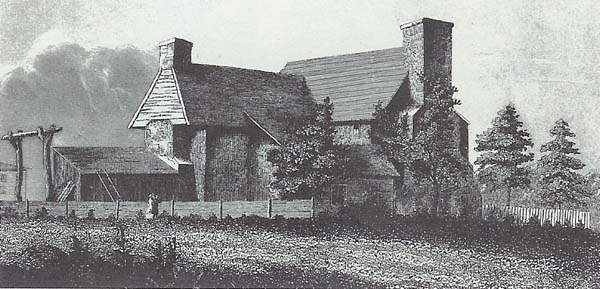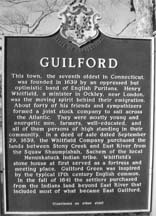1. George Chatfield & Isabel Nettleton
George Chatfield
- 6th child of Henry Chatfield & Jane (Shepard) Wickham—and progenitor of majority of American Chatfields
- Born: Mar 20, 1623/24, North Mundham, Sussex, England
- Died: Jun 8, 1671 (age 47), Killingworth, Middlesex, Connecticut
- Buried: prob Old Cemetery in Killingworth, Middlesex, Connecticut
- Emigrated: 1639 to New England as an original inhabitant of Guilford, New Haven, Connecticut
- Removed: 1663, Killingworth, Middlesex, Connecticut
- Occupation: Farmer
- Religion: Puritan
- Married (1): Mar 29, 1656, Sarah Bishop, Guilford, New Haven, Connecticut
- There may have been a daughter born to George & Sarah: Abigail Chatfield
- Married (2): Jan 9, 1659, Isabel Nettleton, Guilford, New Haven, Connecticut
- Three children: JOHN CHATFIELD, George Chatfield, Mercy Chatfield
(m1). Sarah Bishop
- Daughter of John Bishop & Ann Stevens
- Born: 1628, England or Guilford, New Haven, Connecticut
- Died: Sep 30, 1657 (age 29) Guilford, New Haven, Connecticut
- Buried: unkn
- Mar 29, 1656, George Chatfield, Guilford, New Haven, Connecticut
- There may have been a daughter born to George & Sarah: Abigail Chatfield
1. Abigail Chatfield
- Born: Born: abt 1656/57, Guilford, New Haven, Connecticut
- Died: prob bef 1677, prob Connecticut
- Buried: unkn
- Married: Jan 18, 1670/71, Marmaduke Potter, Killingworth, Middlesex, Connecticut
- No children
- Marmaduke Potter: Son of John Potter & unkn
- Christened: May 10, 1640, St. Denys Parish, City of York, Yorkshire County, England
- Died: Dec 19, 1694, Woodbridge, New Jersey
(m2). Isabel Nettleton
- Daughter of Samuel Nettleton & Maria/Mary ____
- Born: abt 1640 Guilford, New Haven, CT [or bef 1638/1640/1643 Milford, New Haven, CT]
- Died: abt 1700 (abt age 60), Killingworth, Middlesex, Connecticut
- Buried: unkn
- Married: Jan 9, 1659, George Chatfield, Guilford, New Haven, Connecticut
- Three children: JOHN CHATFIELD, George Chatfield, Mercy Chatfield
1. JOHN CHATFIELD
- Born: Apr 8, 1661, Guilford, New Haven, Connecticut
- Died: bef Mar 7, 1746/47 (abt age 85), Derby, New Haven, Connecticut (date will was proved)
- Buried: prob Old Derby Burying Grounds aka Colonial Cemetery, Derby, New Haven, Connecticut
- Occupation: Tailor
- Married: Feb 5, 1683/84, ANNA HARGER, Derby, New Haven, Connecticut
- Ten children: Daniel, Sarah, Mary, Abigail, John(1), Hannah, John(2), Samuel, EBENEZER, Solomon
2. George Chatfield, II
- Born: Aug 18, 1668, Killingworth, Middlesex, Connecticut
- Died: May 2, 1735 (age 66), Killingworth, Middlesex, Connecticut
- Buried: unkn
- Religion: Congregational
- Occupation: Constable (advisor to governor in affairs of Killingworth, Middlesex, Connecticut)
- Married (1): Feb 10, 1692, Hester Hull, Killingworth, Middlesex, Connecticut
- Twelve children: Esther, George III, Hammi, John, Abigail, Josiah, Esther, Cornelius, Naomi, Mary(1) (twin), Philip (twin), Mary(2)
- Married (2): Oct 30, 1719, Silence (Mansfield) Wilcox (widow of Obadiah Wilcox), Killingworth, Middlesex, Connecticut
3. Mercy Chatfield
- Born: Apr 26, 1671, Killingworth, Middlesex, Connecticut
- Died: unkn, but prob died young
- Buried: unkn
George Chatfield & Isabel Nettleton
History, Notes, Letters, etc.:
George emigrated in 1639 from North Mundham, Sussex Shire, England on the ship St. John to New England and was an original inhabitant of Guilford, New Haven, Connecticut.
| WHITFIELD HOUSE, GUILFORD, CONNECTICUT |
| In 1638, Henry Whitfield resigned his position of the Ockley church. He gathered around him twenty-five families of young people (he himself was forty-six at that time) and made plans to emigrate. Most of the Puritan men he attracted were farmers of Surrey and Kent; a few came from the north of England.During the rough long voyage across the Atlantic, Whitfield drew up an agreement which he required all the heads of the families accompanying him to sign. It has come down to us as the Guilford Covenant:We whose names are here underwritten, intending by God’s gracious permission to plant ourselves in New England, and if it may be, in the southerly part about Quinnipiack, do faithfully promise each, for ourselves and our families and those that belong to us, that we will, the Lord assisting us, sit down and join ourselves together in one entire plantation and be helpful each to the other in any common work, according to every man’s ability and as need shall require, and we promise not to desert or leave each other or the plantation, but with the consent of the rest, or the greater part of the company who have entered into this engagement. As to our gathering together in a church way and the choice of officers and members to be joined together in that way, we do refer ourselves, until such time, as it shall please God to settle us in our plantation. In witness whereof we subscribe our names, this first of June, 1639. (Note: Francis Chatfield is the 19th of 25 signatures, he being considered the head of the family at age 24).Henry Whitfield and his group were trekking into a wilderness where nothing new could be had unless they made it with their own hands, grew it from their own stocks or had it shipped from England, the last taking six months to a year. They were completely isolated, completely dependent upon themselves to create a new village in the virgin country.The Henry Whitfield House was built in 1639. It stands today as a reminder and a symbol of the men and women who settled our country. When it was built the house served many purposes. It was the home of Reverend Whitfield and his family. It was church, meeting house, and fort to the families that came with Reverend Whitfield and founded Guilford. To travelers between the existing settlements of Saybrook and New Haven, it was shelter halfway between those two towns. Today as a state museum, the Henry Whitfield House is regarded as the oldest known stone house in New England.The earliest known print of the Henry Whitfield House shows the dwelling much as it appears today. The print is from the Ladies’ Repository Magazine, circa 1842. |
| Source: A State Historical Museum, Guilford, Connecticut Copyright 1970, Trustees of Henry Whitfield Museum |
 Henry Whitfield House, Guilford, CT
Henry Whitfield House, Guilford, CT
| HISTORY OF GUILFORD: THE COLONISTS |
| In May of 1639, a group of Puritans set sail from London. They were seeking freedom from religious persecution by the English government and the Church of England (Anglican Church). Their destination was the New World—first, the plantation of Quinnipiac (New Haven) and then on to settle their own plantation nearby. After a six-week voyage across the Atlantic Ocean, they arrived safely in New Haven harbor. In late September, they purchased a large tract of land from Native Americans midway between New Haven and Saybrook Fort. They called their new home the plantation of Menuncatuck after the Native Americans who lived here. Four years later, in 1643, they chose the name Guilford. Although no written documentation exists, the name was most likely taken from Guildford in the county of Surrey, England—the area where some of the settlers had lived.In the fall of 1639, the colonists began constructing the 40 to 45 homes that would make up the village. Most were simple, one- or two-room, wood frame houses of medieval design. But four large stone houses were constructed as the town’s defensive system. This differed from other New England settlements that were typically surrounded by tall palisades (fences) for protection. Four leaders in the community, including their minister Henry Whitfield, were called upon to build and maintain the fortified stone houses. They lived in them year round, and in times of need, their neighbors would enter for protection.They were concerned about three different threats – the King of England, other European settlers (particularly the Dutch), and Native Americans. They had just fled religious persecution in England, and they were concerned that the king would send English troops to punish them. The Dutch, who were at war with the English, were living nearby in New Amsterdam (New York City) and had trading posts throughout the region. And although they had friendly relations with the Menuncatucks and nearby tribes, there was concern that less friendly Native Americans would come into the area. |
| Source: Henry Whitfield State Museum, Guilford, Connecticut |
 Guilford Town Monument
Guilford Town Monument
GUILFORD MONUMENT: “This town, the seventh oldest in Connecticut, was founded in 1639 by an oppressed but optimistic band of English Puritans. Henry Whitfield, a minister in Ockley, near London, was the moving spirit behind their emigrations. About forty of his friends and sympathizers formed a joint stock company to sail across the Atlantic. They were mostly young and energetic men, farmers, well-educated, and all of them persons of high standing in their community.
In a deed of sale dated September 29, 1639, the Whitfield Company purchased the lands between Stony Creek and East River from the Squaw Shaumpishuh, Sachem of the local Menunkatuck Indian tribe. Whitfield’s stone house at first served as a fortress and meeting place. Guilford Green was inspired by the typical 17thcentury English common. In the fall of 1641 the settlers purchased from the Indians land beyond East River that included most of what became East Guilford.”
1663: After farming the land on which Guilford is founded, George Chatfield (age 40) and his family move from Guilford, New Haven, Connecticut to Killingworth, Middlesex County, Connecticut. He becomes one of the town’s prominent men, holding the office of constable.
| KILLINGWORTH, MIDDLESEX COUNTY |
| “Descendants of three Chatfield brothers, who arrived from England about 1639, were believed to have operated a gristmill along the brook… making use of the stream for waterpower. Occasional chunks of oddly shaped metal fragments found near the watercourse are evidence that an iron smelting furnace worked native ores into metal for implements. Other reminders of early history include several old building foundations, a restored waterwheel on the upper pond, and the covered bridge reproduction spanning Chatfield Hollow Brook.” |
| Source: Website of Chatfield Hollow State Park, Killingworth |
| Note from Find A Grave contributor: |
| “In these early cemeteries, there were no records kept; people dug a hole someplace in the burying grounds and buried their friend/relative there. There were no family plots and husbands and wives were often not buried together, unless they died at the same time. Generally someone else might have been buried on either side. It was random and first come.” |
| Note: Reference contributed by Jim Ottmer: |
| Mar 14, 2007: Note from Cheryl (Chatfield) Thompson to Catherine (Clemens) Sevenau: |
| Sulphur, Colorado Catherine, Wanted you to know (in case you didn’t) there is “Chatfield State Park” at Killingworth, also named after this branch of the Chatfield’s, supposedly built on the land the Chatfield’s owned. I have been there, but it was Sunday with no city offices or libraries open to find out any information. Located a foundation with the chimney still standing on the land. What a feeling to stand in the middle of it and imagine my ancestors who left everything they knew and owned to build on that site. Cheryl (Chatfield) Thompson |
| Cheryl is a co-contributor to this site |